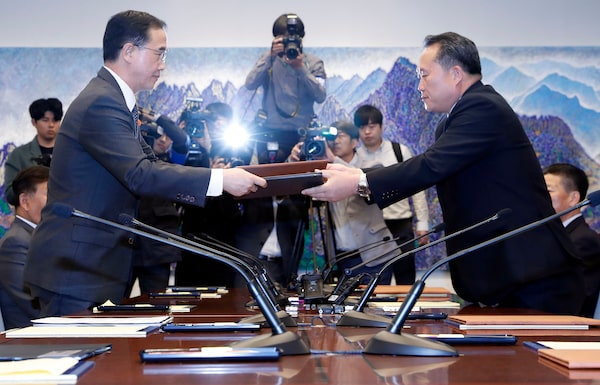
South Korean Unification Minister Cho Myoung-gyon, left, exchanges the joint statement with his North Korean counterpart Ri Son Gwon during their meeting at the southern side of Panmunjom in the Demilitarized Zone, South Korea, Oct. 15, 2018.The Associated Press
Korean negotiators have rekindled visions of fast trains travelling from Seoul to Pyongyang – and, perhaps, onward to Beijing and Moscow – with an agreement that promises a new era of railway reunification, if that can be done without violating sanctions.
Representatives of the two countries met on Monday at the Panmunjom peace village, in the heart of the heavily militarized demilitarized zone, and struck a deal to begin work in late November or early December on a project to modernize North Korea’s creaking rail system and once again stitch together the peninsula with track. The new era of railway reunification, however, would first need to clear a significant hurdle: crippling economic sanctions aimed at North Korea that bar most kinds of investment in the country.
The region’s first railways were built long before the Korean War, which began in 1950, and originally connected north and south as the single jurisdiction they were then. The idea of reconnecting those historic links carries potent meaning.
“This is, symbolically at least, a way to start reunifying the peninsula – undoing historical wrongs,” said Justin Hastings, a scholar at the University of Sydney and author of A Most Enterprising Country: North Korea in the Global Economy.
That is, if Seoul and Pyongyang can find a way to overcome the sanctions that largely block investment into North Korea, barriers unlikely to fall unless North Korea makes steps toward denuclearization.
Sanctions mean ”there isn’t much space for the South to do much beyond what’s on paper,” said Cheng Xiaohe, an international politics scholar at Renmin University in Beijing. “In spite of all the positive signals coming out, it would be naive to believe that something tangible would come out of this project any time soon.”
Treat the rail deal, he said, as a hopeful signpost.
“With an agreement like this, South Korea is telling the world that they are in a period of preparation with North Korea, and once the removal of sanctions comes to pass, they will be prepared to start large-scale co-operation.”
Rail reunification has been a long-standing ambition for North Korean leaders. Kim Il-sung, North Korea’s founding dictator, held up trains as a symbol of modernity and, in the weeks before his death in 1994, spoke excitedly about re-establishing a train link that would allow him to travel south for reunification talks, according to an account in Under the Loving Care of the Fatherly Leader.
His son Kim Jong-il, the country’s second dictator, was a notable rail lover, travelling as far as Moscow on a private train supplied with live lobsters en route.
Under him, the two Koreas began investing in tracks and trains that could straddle the military demarcation line, an effort that dates to an earlier detente two decades ago. Trains made several journeys between the two countries in 2007.
But little has been done to improve a North Korean rail network that is an outdated outlier in a region where bullet trains have made 300-kilometre-an-hour travel commonplace. It takes trains 5½ hours to travel to Pyongyang from the Chinese border city of Dandong, a land distance as the crow flies of 175 kilometres.
“It’s just slow,” said Simon Cockerell, general manager of Beijing-based Koryo Tours, one of the leading travel companies operating trips to North Korea. He has ridden that route more than 100 times. North Korea’s “rail system is notoriously inefficient,” he said. “It’s infrastructure, and a lot of infrastructure there needs to be upgraded.”
South Korean officials have sketched plans to invest in the northern train network, even affixing a potential budget figure – $43.6-billion – to the project.
For North Korea, visions of better trains took on new substance in February, when Kim Yo-jong, sister of Supreme Leader Kim Jong-un, travelled to the site of the Pyeongchang Winter Olympics on a South Korean bullet train. It flew in two hours across a distance it might have taken most of a day to cover on a northern train. “She was basically transported like she was in Star Trek,” said Bong Youngshik, a research fellow with Yonsei University Institute for North Korean Studies.
In North Korea, that “accentuated the already existing very strong desire to update the railroad.”
Indeed, “it’s fair to say that railway construction is the key to North Korea’s economic development,” said Lu Chao, a North Korea expert at the Liaoning Academy of Social Sciences.
Making public an agreement “to reconnect rail and roads means co-operation between the two Koreas has reached a tangible new era, despite discontent from [the U.S. administration],” he said, calling it a “huge step forward.”
For South Korea, meanwhile, rail links to – and through – the northern peninsula stand to end its de facto status as an island, creating a land link for its goods to China, Russia and beyond. The establishment of such links could bring North Korea revenue from transiting cargoes, too, and serve as a preliminary test case for its ability to assure foreign shippers their goods “will not be expropriated along the way or stopped with surprise fees,” Prof. Hastings said.
But for now sanctions remain – as does North Korea’s nuclear program.
Christopher Green, a senior adviser at the International Crisis Group, likens it to “the Brexit impasse. As it stands, North Korea is not denuclearizing, and South Korea is not implementing economic engagement plans in a substantive way. Something will eventually have to give: Is it the [Washington-led] alliance, or is it inter-Korean relations?”
Any plan for new economic co-operation depends “on North Korea actually giving up something concrete,” Prof. Hastings said. “Which they have, as of yet, not done.”
With reporting by Alexandra Li
 Nathan VanderKlippe
Nathan VanderKlippe